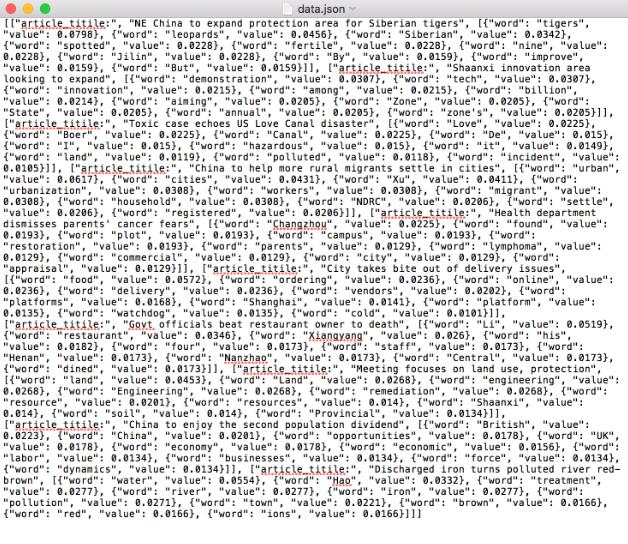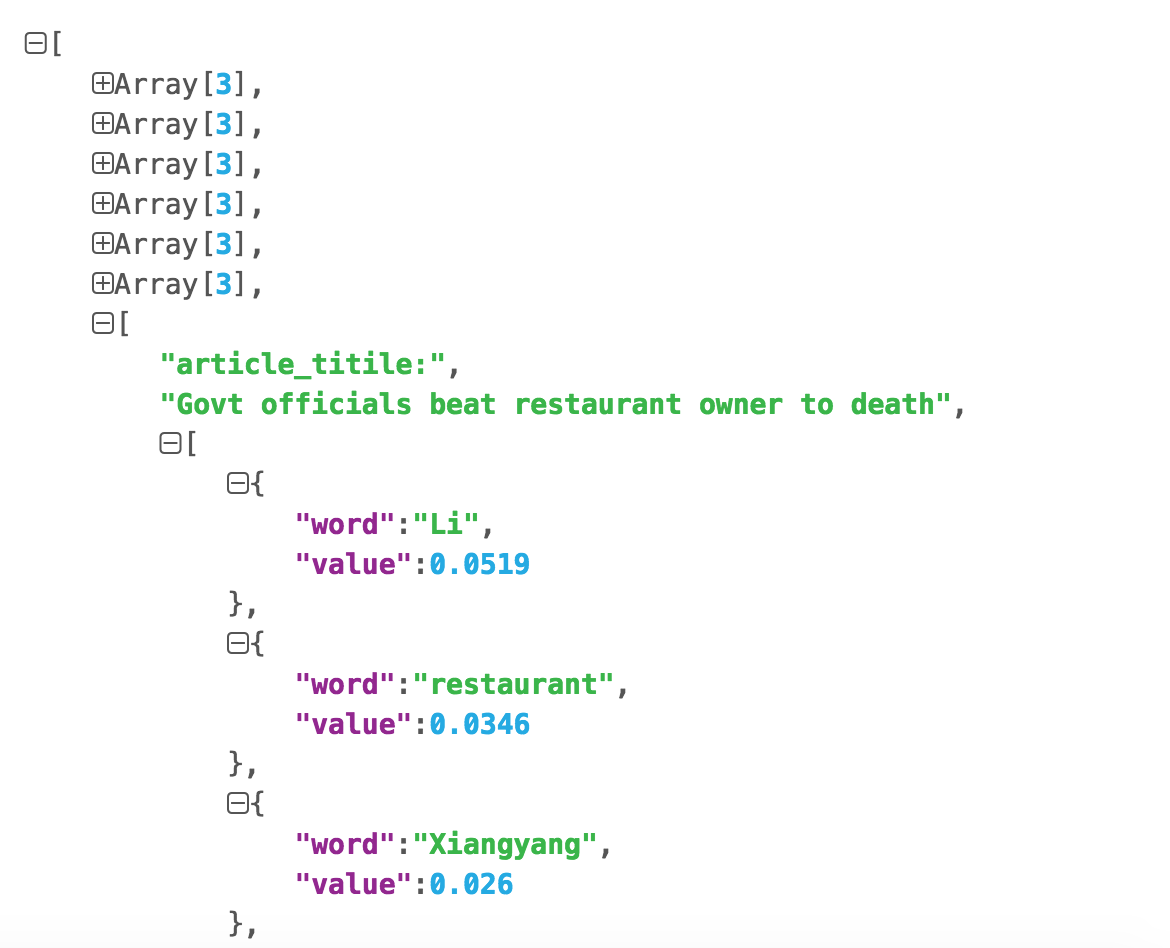您好,登錄后才能下訂單哦!
您好,登錄后才能下訂單哦!
統計十篇新聞TF-IDF
統計TF-IDF詞頻,每篇文章的 top10 的高頻詞存儲為 json 文件
TF-IDF
TF-IDF(term frequency–inverse document frequency)是一種用于資訊檢索與文本挖掘的常用加權技術。TF-IDF是一種統計方法,用以評估一字詞對于一個文件集或一個語料庫中的其中一份文件的重要程度。字詞的重要性隨著它在文件中出現的次數成正比增加,但同時會隨著它在語料庫中出現的頻率成反比下降。TF-IDF加權的各種形式常被搜索引擎應用,作為文件與用戶查詢之間相關程度的度量或評級。除了TF-IDF以外,互聯網上的搜索引擎還會使用基于連結分析的評級方法,以確定文件在搜尋結果中出現的順序。
假如一篇文件的總詞語數是100個,而詞語“母牛”出現了3次,那么“母牛”一詞在該文件中的詞頻就是3/100=0.03。一個計算文件頻率(DF)的方法是測定有多少份文件出現過“母牛”一詞,然后除以文件集里包含的文件總數。所以,如果“母牛”一詞在1,000份文件出現過,而文件總數是10,000,000份的話,其逆向文件頻率就是log(10,000,000 / 1,000)=4。最后的TF-IDF的分數為0.03 * 4=0.12。 —— [ 維基百科 ]
博主選擇的是chinadaily的十篇新聞.
1.使用http request請求
2.使用Beautiful Soup來抓取文章標題和內容
3.統計TF-IDF
4.保存到json文件中
代碼塊
@requires_authorization
#coding=utf-8
import requests
import bs4
import sys
import math
import json
reload(sys)
sys.setdefaultencoding('utf-8')
url_list = ['http://www.chinadaily.com.cn/china/2016-04/20/content_24701635.htm',
'http://www.chinadaily.com.cn/china/2016-04/20/content_24700746.htm',
'http://www.chinadaily.com.cn/china/2016-04/20/content_24681482.htm',
'http://www.chinadaily.com.cn/china/2016-04/19/content_24675530.htm',
'http://www.chinadaily.com.cn/china/2016-04/19/content_24675455.htm',
'http://www.chinadaily.com.cn/china/2016-04/19/content_24674074.htm',
'http://www.chinadaily.com.cn/china/2016-04/19/content_24655536.htm',
'http://www.chinadaily.com.cn/china/2016-04/18/content_24643685.htm',
'http://www.chinadaily.com.cn/china/2016-04/18/content_24636917.htm',
'http://www.chinadaily.com.cn/china/2016-04/15/content_24562198.htm'
]
articles_title = []
articles_content = []
for pos,url in enumerate(url_list):
r = requests.get(url)
soup1 = bs4.BeautifulSoup(r.text)
soup2 = bs4.BeautifulSoup(str(soup1.find_all(id="Title_e")))
articles_title.append(soup2.h2.string)
mystr = ""
soup3 = bs4.BeautifulSoup(str(soup1.find_all(id="Content")))
for x in soup3.find_all("p"):
mystr = mystr + x.string
str_p = ""
contents = []
for pos,x in enumerate(mystr):
if x == '.' or x == ',':
if pos < (len(mystr) - 1) and mystr[pos+1] >= '0' and mystr[pos+1] <= '9':
str_p = str_p + x
elif str_p == "":
continue
else:
contents.append(str_p)
str_p = ""
elif x == '(' or x == ')' or x == ' ' or x == '"' or x == '[' or x == ']' or x == '-':
if str_p == "":
continue
else:
contents.append(str_p)
str_p = ""
else:
str_p = str_p + x
articles_content.append(contents)
Dict_idf = {}
DictList = []
for content in articles_content:
Dict_tf = {}
for x in content:
if not Dict_tf.has_key(x):
Dict_tf[x] = 1.0
if not Dict_idf.has_key(x):
Dict_idf[x] = 1.0
else:
Dict_idf[x] += 1.0
else:
Dict_tf[x] += 1.0
for k, v in Dict_tf.items():
Dict_tf[k] = v / len(content)
DictList.append(Dict_tf)
for k, v in Dict_idf.items():
Dict_idf[k] = math.log(float(len(url_list)) / v)
for pos,x in enumerate(DictList):
for k,v in x.items():
DictList[pos][k] = v*Dict_idf[k]
DictList[pos] = sorted(x.iteritems(), key=lambda d: d[1], reverse=True)
"""
[
[
article_titile:"XXXX"
[
{
word:"hello"
value:3.5
}
{
word:"hello"
value:3.5
}
{
word:"hello"
value:3.5
}
...
]
]
]
"""
data = []
for pos in range(10):
data2=[]
data2.append("article_titile:")
data2.append(articles_title[pos])
data2.append([{"word": k,"value":round(v,4)} for k,v in DictList[pos][:10]])
data.append(data2)
# Writing JSON data
with open('data.json', 'w') as f:
json.dump(data, f)

使用json.cn查看數據:

github地址:https://github.com/mqsee/learngit
以上就是本文的全部內容,希望對大家的學習有所幫助,也希望大家多多支持億速云。
免責聲明:本站發布的內容(圖片、視頻和文字)以原創、轉載和分享為主,文章觀點不代表本網站立場,如果涉及侵權請聯系站長郵箱:is@yisu.com進行舉報,并提供相關證據,一經查實,將立刻刪除涉嫌侵權內容。